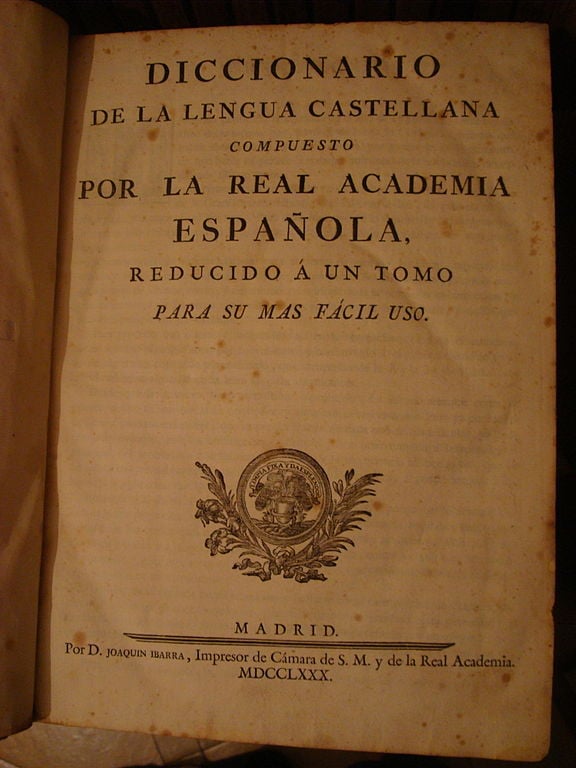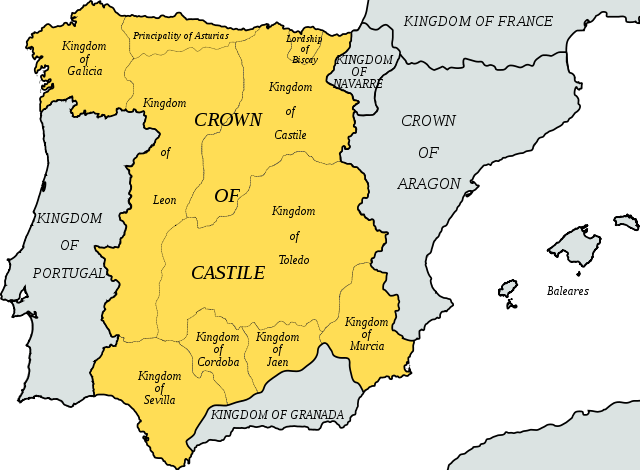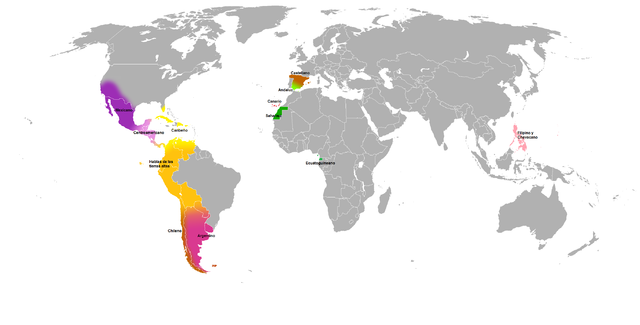Spanish Dialects for All: Is One Dialect Better Than the Other?
The Spanish language that we all know and love today originated in Spain. Though it has evolved differently in each of the 20 countries that have it as an official language, all the Spanish dialects are mutually intelligible among each other.
The Real Academia Española acts as a sort of language governing body since 1713. As a result, the language as it is taught, read, written, and spoken still retains much of the same roots.
However, due to centuries of different socio- and geopolitical divides during the reign of the Spanish Empire, the language has had time to blossom and transform into variations quite different than what it originally was. Currently, in the United States, Spanish has grown due to immigration and an increase in business from Spanish-speaking countries.

Photo via Wikimedia
As a result, the sheer fact of being able to speak Spanish places a worker in a different category when applying to jobs. It is not only beneficial for the employee but it also advantageous for the company as well.
The Hispanic population in the US is estimated to be 24.3% by 2050, with Spanish speakers adding 9.2% to the world’s GDP in North America and the European Union.
Taking this into consideration, which dialect is the best to learn? These findings would suggest a mixture of Latin American and European Spanish as the necessary Spanish to use for your career, right? Well, let’s take a further look into dialect acceptance in the corporate world and then let you be the judge of its importance. Before getting started, though, it’s important that we establish a few things:
First:
What is a dialect? A dialect is defined as a variation of a language that is used by a group of people from a particular geography.
Second:
Linguistic disclaimer: In this article, 5 particular different Spanish dialects are discussed that correspond to generalized linguistic features for each respective region. Please note that these groupings were chosen for editorial purposes and are not meant to discriminate nor disregard any country in Latin America, Spain, or Spanish-speaking territories.
Now the fun part: let’s break down the Spanish dialects.
Take a Free Trial Spanish class online with one of our qualified native teachers!
Table of Contents

Photo via Wikipedia
Castilian Spanish
The Kingdom of Spain was once formed from the merging of Kingdoms Navarre and Aragon with the Crown of Castille. Sound familiar? That’s right. Castilian Spanish, or Spanish from Spain, as it is known in English today, is where it all began.
To equate it to an Anglophone ear, Castilian Spanish has a relationship remarkably alike to British English and American English, because the latter stemmed from the prior. Linguistic features to highlight:
- “Le” versus “lo/la” as direct object.
- “Ll” sounds similar to “y” as in “YAAAHS.”
- “Vosotros” is used over “ustedes.”
- There’s Ceceo, meaning that “ci,” “z,” and “ce” are distinguished with a “th” sound. For example, Barcelona becomes Barthelona.
Bear in mind that there are many different Spanish dialects within Spain. The characteristics mentioned here apply mainly to the Madrilenian variety.
Latin American Spanish Dialects
To reiterate, with Latin American dialects please understand that I am making blanket statements to better show the linguistic differences presented within each region.
“Gran Colombia”
“Gran Colombia” is a made-up umbrella term for this article in order to represent the shared linguistic features in the countries Colombia, Peru, Ecuador, and [barely touching] Bolivia.
While there are many different regions within each country and Spanish dialects galore, there is a remarkable similarity throughout the whole region: clear, consistent vowel and consonant pronunciation. This is said to be the Spanish often used in the business world in the United States and is more commonly taught than Castilian Spanish simply for that reason.
At times, the respective dialect can be almost indistinguishable within the region and still maintains its Castilian roots, but with a simpler, more relaxed twist. Linguistic features:
- “Lo”/”la” for direct objects.
- “Ll” can be a “y” sound or a “j” sound as in “judge.”
- “Ustedes” instead of “vosotros”, always.
- Quichua/Quechua grammatical structure and vocabulary.
Chilean
Despite its setting on the Southwest coast of South America, Chile had quite an impact due to European colonization in the 19th and 20th centuries. The Chilean Spanish dialect is unique because it was influenced by the Andalusian Spanish dialect, as well as by indigenous languages such as Quechua and Mapudungun.
That, mixed with the geographical division and isolation from the rest of South America, makes Chilean Spanish an extremely interesting dialect to study.
Linguistic features:
- “S” is completely dropped, not even aspirated.
- 4 grades of formality instead of 2-3 (vos, voseo verb tú, standard tú, and used).
- Unique slang.
- “Ch” and “sh” reversal.
- Irregular intonation dips.
River Plate (Rioplatense/Río de la Plata)
The River Plate dialect is characteristic of Uruguay, and the South-Eastern part of Argentina (engulfing Buenos Aires). The River Plate dialect was influenced by the Spanish colonization of the region due to the Viceroyalty of the Río de la Plata in the 17th century and the Italian immigration along with numerous other countries. This Spanish is called Castellano and Rioplatense is similar to Chile in that was influenced by the indigenous languages like the Guaraní and Quechua.
Linguistic features:
- Voseo (vos) in place of tuteo (tú).
Hablas→hablás, Comes→comés, Escribes→escribís
- “Ll” and “y” become a “sh.”
- Elongated intonation: the “sing-songy” Italian influence.
- Lunfardo: slang specific to Buenos Aires but spoken throughout the region.
- Aspirated “s”: Oscar becomes Oh-car.
- Sharp trilled “r.”
Caribbean
The Caribbean dialect demonstrates the great divide in Castilian Spanish that arose in the 17th and 18th centuries. This dialect arrived in the Caribbean and coastal areas of Latin America via ships that embarked from Andalusia, Southern Spain on trade missions in the new world.
Thus, there is a notable resemblance with the Spanish spoken in the Canary Islands and Andalusia as well as Cuba, Puerto Rico, the Dominican Republic and the Caribbean coast of South America.
Linguistic features:
- Aspirated “s” sound: haciendo→ ah-hee-en-do
- Rapid speech
- Syllables are left out at the end of words so “comer” is “come” or “desarollado” is “desarollao”

Photo via Wikipedia
Now that we’ve covered that, what does it all mean? What did that prove? What it proves is exactly what you thought: there is no Spanish dialect that is particularly better to learn than another.
At present, business is booming in most Spanish-speaking countries and the most important aspect to keep in mind is what demographic you are trying to reach. There is an unspoken understanding that there is no proof that one dialect is better than the other. So, no matter which Spanish dialect you choose, as long as you respect the regional differences and terminology it will always be useful to you in the business world.
Take a Free Trial Spanish class online with one of our qualified native teachers!
Editor’s note: Article updated on July 29, 2021
